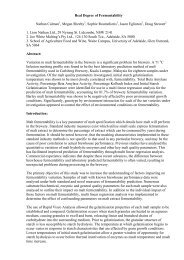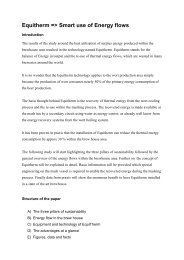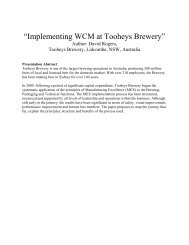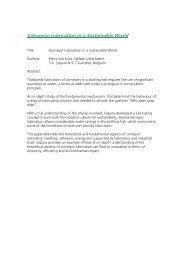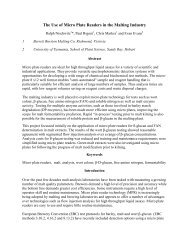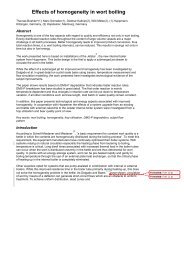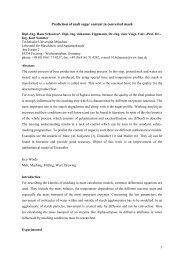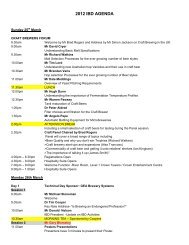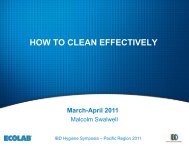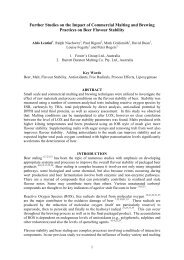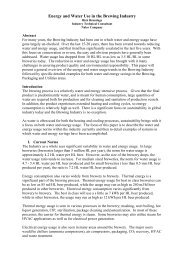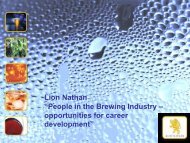Bitter Apples For Cider Making - An Alternative
Bitter Apples For Cider Making - An Alternative
Bitter Apples For Cider Making - An Alternative
Create successful ePaper yourself
Turn your PDF publications into a flip-book with our unique Google optimized e-Paper software.
<strong>Bitter</strong> <strong>Apples</strong> <strong>For</strong> <strong>Cider</strong> <strong>Making</strong> - <strong>An</strong> <strong>Alternative</strong>.<br />
Richard Badcock 1 *, Gabriel Gressie 1 , Maxwell Burslem 1 , Neil Barker 2 .<br />
1 Cascade Brewery, Hobart, Foster’s Australia.<br />
2 Abbotsford Brewery, Melbourne, Foster’s Australia<br />
Abstract<br />
Traditional alcoholic apple ciders often combine varieties of “bittersweet”,<br />
“bittersharp” and “culinary” apples to give mouthfeel balance between bitterness,<br />
acidity, and alcohol content. The bitter component is derived from apple<br />
polyphenols which confer astringency to cider, producing an effect which is<br />
similar to that of tannins from oak contact in wine production.<br />
These bitter apple varieties are quite specialised, having poor appeal as<br />
table or dessert fruit, and tend to be grown exclusively for cider production. The<br />
lead time and infrastructure required to establish such perennial horticultural<br />
crops is significant, leading to a relatively expensive product with slow response<br />
to increasing demand.<br />
At the Cascade Brewery we have identified immature dessert and culinary<br />
apples as an alternate source of apple polyphenols, having typically six times the<br />
concentration of tannins that so called “bitter” varieties contain. These immature<br />
apples are widely available from table fruit production at the thinning stage, very<br />
early in the growing season.<br />
Methods for fruit collection, storage, processing and use have been<br />
developed, together with final cider product flavour matching, to commercialise<br />
this alternate raw material as an economical source of apple polyphenols.<br />
Importantly, since the process utilises an existing surplus resource, it also offers<br />
considerable flexibility in meeting demand changes at short notice.<br />
Key Words: cider, apples, bittersweet, polyphenol.<br />
Introduction<br />
<strong>Apples</strong> originated in the Middle East or Central Asia, and have been<br />
cultivated for more than 4000 years. Initially cultivated for eating, they have also<br />
been used for at least 1000 years to make the fermented alcoholic apple juice<br />
product known as cider, in Southwest England and Northwest France (Lea).<br />
There are more than 7500 known cultivars of apple (Elzebroek). While a<br />
majority are for eating, there are a significant number of cultivars that are<br />
principally for cooking or cider making. In general terms, table fruit tends to be<br />
quite sweet with a low to moderate acidity; cooking fruit is similar but may have a<br />
higher acidity level. Traditional cider apples may have either low or high acidity,<br />
however, they are also typically distinguished by an elevated polyphenol<br />
content.(Lea), often loosely referred to as “high tannin” It has been postulated<br />
that high tannin fruit cultivars were initially selected for cider making because of<br />
disease resistance advantages for the tree, or possibly because of anti-bacterial<br />
properties in the final beverage. (Lea)
There are six main polyphenol classes found in apples. Lea states that,<br />
two of these, the anthocyanins and flavonol glycodises ,are found mainly in the<br />
skin and do not play a significant role in juice or cider products. Fig 1, Fig 2.<br />
Fig 1. Quercetin 3 glucoside – skin polyphenol<br />
Fig 2. Cyanidin 3 Glucoside - skin polyphenol<br />
Lea further states that the remaining 4 classes of polyphenols are:<br />
• Phenolic acids: principally chlorogenic and p-coumaroyl quinic acid<br />
• Dihydrochalcones: phloretin and its glycosides, principally phloridzin<br />
• Catechins: principally (-) epicatechin<br />
• Procyanidins: principally the 4 beta 8 linked epicatechin series. e.g. dimer<br />
B2, with smaller amounts of other-linked and (+) catechin/(-) epicatechin<br />
series.
These 4 classes of compounds do play an important role in the qualities of apple<br />
products.(Lea, Shahidi)<br />
Fig 3. Chlorogenic acid<br />
Fig 4. Phloridzin<br />
Fig 5. (-) Epicatechin<br />
Fig 6. Procyanidin B2
A key property conferred on cider by these polyphenols, particularly the<br />
procyanidins, is the taste perception of bitterness or astringency.<br />
<strong>Bitter</strong>ness, also referred to as “hard” tannin, is associated with lower levels<br />
of polymerization and low procyanidin molecular weight.<br />
Astringency, also referred to as “soft” tannin, is associated with increasing<br />
levels of polymerization and molecular weight.(Lea).<br />
In today’s beverage market, ciders can be made from juice or juice<br />
concentrates derived solely from culinary or dessert apples, or solely from<br />
traditional cider apples. But a considerable number of ciders are made from a<br />
blend of both culinary / dessert and traditional cider apples.<br />
Commercial culinary apple juice concentrate (8 times concentrated = 71<br />
brix) typically contains 1500 – 3000 mg/L polyphenol. This is equivalent to 190 –<br />
375 mg/L at fresh juice strength. Lachman et al (2006) have reported total<br />
polyphenol in juice from table apples ranging from 78 to 697 mg/l with<br />
considerable variation between varieties but even more between analysis<br />
methods. He compared the EBC total polyphenol method with the Folin-<br />
Ciocalteau (FC) method.<br />
Commercial European bittersweet apple concentrate typically contains<br />
9000 – 16000 mg/L polyphenol. This is equivalent to 1100 – 2000 mg/L at fresh<br />
juice strength.<br />
Recent increased popularity of cider both in Europe and Australia lead to<br />
an acute shortage of so called “bittersweet” apple juice and apple juice<br />
concentrate, resulting in poor availability and increased cost<br />
<strong>Apples</strong> are a perennial crop, so there is substantial cost, infrastructure and<br />
time delay required to increase crop capacity if demand for a particular cultivar<br />
(or group of cultivars) exceeds supply. As there was little or no prospect of<br />
immediate reliable supply, a search for suitable substitutes was undertaken.<br />
Potential commercial sources of polyphenol that were considered for<br />
inclusion in cider production were tea polyphenol, oak tannins, oak chips, and<br />
grape polyphenol. These were taste trialed at a lab scale in a cider base, and<br />
found to be a poor flavour match to cider produced using traditional bittersweet<br />
apple concentrate. There were also physical stability problems with cider<br />
containing these alternatives.<br />
<strong>An</strong>other potential source was crab apples. These have traditionally been<br />
used in some styles of alcoholic cider. Crab apples have been noted by Shahidi<br />
to produce juices with 390 – 1350 mg/L chlorogenic acid. As chlorogenic acid<br />
comprises around 6-10% of total polyphenols (Shahidi) this implies a total<br />
polyphenolics level in juice from mature crab apples of 3900 – 22000 mg/L. This<br />
compares to reports of juice from table varieties of apple which, when mature,<br />
have implied total phenolics ranging from 15 – 3000 mg/L. However, there are no<br />
commercial quantities of crab apples grown in Tasmania, and juice concentrates<br />
from crab apples also are not known to be available.<br />
Brown at al (2001) have reported total polyphenol levels of 3000 – 6000<br />
mg/kg in apple skin material, and around 15000 mg/kg in apple leaf material. The<br />
proportions of polyphenol classes was not identified, however, it would seem
from the observations of Lea, that they are likely to be different to that normally<br />
found in juices and ciders.<br />
Elevated levels of apple polyphenols in immature fruit has been reported<br />
(Martin, Tanabe et al, Gordon Brown pers comm.) Much previous work has<br />
focused on purification of these components and their application as<br />
antioxidants, alternatives to tea polyphenols, and for physiological effects.<br />
(Tanabe et al, Kanda et al). These polyphenols include chlorogenic acid,<br />
catechin, epicatechin, rutin and condensed tannins (Kanda et al 1998). They are<br />
essentially the same compounds that occur in juice and cider products derived<br />
from mature fruit, but at higher concentrations.<br />
It was recognised that immature fruit from crop thinning operations could<br />
potentially be processed using regular juice production methods, and<br />
concentrated into a “super” bittersweet apple concentrate for inclusion as a<br />
substitute raw material in cider making.<br />
Martin identifies that commercial quantities of apple thinnings are<br />
potentially available, and has reported the relationship between total polyphenol<br />
content, apple variety, size and thinning date for some cultivars under Tasmanian<br />
conditions. (Fig 7 and Fig 8).<br />
Polyphenol mg/L vs Date by Variety<br />
16.0<br />
14.0<br />
mg/L Polyphenol (Thousands)<br />
12.0<br />
10.0<br />
8.0<br />
6.0<br />
4.0<br />
2.0<br />
Red Delicious spur<br />
Hi Early Red Delicious<br />
Democrat<br />
Crofton<br />
Fuji<br />
Granny Smith<br />
Golden Delicious<br />
0.0<br />
22 NOV<br />
'95<br />
28 NOV<br />
'95<br />
04 DEC<br />
'95<br />
13 DEC<br />
'95<br />
05 JAN<br />
'96<br />
Fig 7. Adapted from Martin (1997)
Fruit diameter vs Date by Cultivar<br />
Average Fruit Diameter (mm)<br />
45.0<br />
40.0<br />
35.0<br />
30.0<br />
25.0<br />
20.0<br />
15.0<br />
10.0<br />
5.0<br />
Red Delicious spur<br />
Hi Early Red Delicious<br />
Democrat<br />
Crofton<br />
Fuji<br />
Granny Smith<br />
Golden Delicious<br />
0.0<br />
22 NOV<br />
'95<br />
28 NOV<br />
'95<br />
04 DEC<br />
'95<br />
13 DEC<br />
'95<br />
05 JAN<br />
'96<br />
Fig 8. Adapted from Martin (1997)<br />
Shahidi et al (1995) note that the major losses of polyphenols in the<br />
processing of apples is brought about by oxidation, and further, that holding pulp<br />
under non-oxidative conditions for up to three hours improves the extraction of all<br />
phenolic compounds from pulp into juice. Gordon Brown performed the analysis<br />
of polyphenol referred to in Fig 7 (personal communication), and confirmed that<br />
these extractions were performed using metabisulphite at the maceration stage.<br />
Lea makes the observation that there are a range of reactions which can remove<br />
polyphenols from apple juice products, including polyphenol - protein complexing,<br />
oxidative polymerization, acid catalysed disproportionation, and aldehyde cross<br />
linking. Gelatine fining of apple juice products to prevent haze formation is a<br />
specific example of protein – polyphenol complexing.<br />
Lea further observes that “all of these reactions can be prevented by the<br />
use of sulphur dioxide, which acts variously as an anti-oxidant, as a blocking<br />
nucleophile, or to form aldehyde-bisulphite adducts.”<br />
It was decided to undertake full scale processing plant trials on immature<br />
apple thinnings to produce Tasmanian Little Green Apple concentrate (TLGA), in<br />
parallel with lab scale investigations into the polyphenol levels of a range of apple<br />
cultivars available at the National Apple cultivar museum orchard at Grove,<br />
Tasmania. This was undertaken from September 2007 through until late January<br />
2008, and examined a selection of table apple, traditional cider apple, and crab<br />
apple cultivars as they developed from flowering onwards.
Experimental<br />
Cultivar evaluations: Fruitlet samples were collected by cultivar. Some<br />
were sub-sampled into “large” or “small” fruitlets to assess the relative influence<br />
of size and date. Fruitlet samples were measured for average diameter, then<br />
weighed. 100 - 200 grams of the fruitlets were then cut into small pieces before<br />
grinding and mixing with a hand held “Bamix” unit. Grinding with, and without,<br />
metabisulphite at circa 300 mg / kg was trialed. A sample of the ground pulp was<br />
then placed in a disposable 10 mL syringe and approximately 2 mL of liquid<br />
collected through a 0.45 um, 25 mm dia, cellulose acetate filter disc.<br />
.<br />
Total Polyphenol levels were measured using a standard Fosters method<br />
(Costanzo, 2003) based on the ASBC and EBC International Method.<br />
The juice samples were diluted 10 fold by volume with distilled water by<br />
modifying the method and including 150 uL of sample instead of the usual 1500<br />
uL, and increasing the distilled water to make up the same volume<br />
The following aliquots were added to a disposable cuvette:<br />
• 800 uL CMC / EDTA reagent<br />
• 150 uL of sample<br />
• 50 uL of Ferric Reagent (samples only)<br />
• 50 uL Ammonia reagent<br />
• 1450 uL of distilled water (use 1500 uL for blank)<br />
After mixing and allowing a reaction time of 10 minutes, the absorbance<br />
was measured against a reagent blank at 600 nm wavelength in a<br />
spectrophotometer. Final result is calculated by multiplying corrected<br />
absorbance at 600 nm x 547 x dilution factor to give results in mg/L.<br />
Processing plant trials: A total of 185 tonnes of fruit thinnings were<br />
collected over a period of 5-7 weeks from mid November until the end of<br />
December. These were collected into waist belt held picking bags, before<br />
consolidation into 0.4 tonne holding bins. The bins of fruitlets were hydro-cooled,<br />
then stored in cool store at 4 degrees C until delivery to the processing plant on<br />
the day of processing.<br />
Fruit was processed on 6 Dec, 13 Dec, 21 Dec and 8-10 January. Milling<br />
occurred using a Rietz mill (10 mm screen) with addition of sodium<br />
metabisulphite solution at milling to give a level of approximately 300 mg/kg<br />
SO2. Some additional water was also added at milling to facilitate pumping to<br />
the mash holding tanks. Pectolytic mash enzyme was added at a rate of<br />
approximately 300 mL/Tonne, before holding for 1 – 2 hours at 20 – 25 degrees<br />
C. Juice was extracted using a Bucher HPX5005i fruit press, then flash<br />
pasteurised into agitated fining tanks where fining agents silica sol and bentonite<br />
were applied. The juice was then cross-flow filtered in a Bucher “Ministar –metal”<br />
unit employing Graver technologies filter elements having 0.1 micron pore size<br />
titanium oxide membranes supported on 316 sintered stainless steel. Finally, the<br />
juice was concentrated in an APV rising / falling film plate evaporator to around
70 brix, before packing into 200 litre polyethylene drums and freezing at -23 deg<br />
C for storage.<br />
Juice samples were collected throughout processing stages and filtered<br />
through a 0.45 um cellulose acetate filter, before testing for brix, acidity and total<br />
polyphenol using the above method.<br />
Juice concentrate (70 brix) samples from the processing plant, and<br />
commercial “bittersweet” concentrates were diluted an additional 10 fold by<br />
volume before testing for total polyphenol content using the method above.<br />
<strong>An</strong>alysis results are shown in the tables below.
nil SO2<br />
Diameter Av weight Brix Polyphenol<br />
Cultivar<br />
(mm) (g)<br />
(refrac 20 deg<br />
C) (mg/L)<br />
Bulmers Norman 16 2.6 7.8 13800<br />
Somerset Redstreak 20 3.3 8.4 12000<br />
Kingston Black (large) 28 7.9 9.3 4500<br />
Kingston Black (small) 23 5.6 9.0 6100<br />
Yarlington Mill 21 4.1 7.1 16000<br />
Michelin<br />
18 2.5 8.1 14300<br />
Sundowner (large) 28 11.2 9.1 8600<br />
Sundowner (small) 19 4.3 8.4 7800<br />
Jonagold (large) 28 12.1 10.3 5300<br />
Jonagold (small) 22 7.0 9.9 6100<br />
Fuji (large) 29 12.2 9.2 4600<br />
Fuji (small) 22 6.2 9.0 4700<br />
Pink Lady (large) 28 11.2 8.9 7100<br />
Pink Lady (small) 24 7.4 8.2 6600<br />
Bramley (large) 27 10.1 8.1 7400<br />
Bramley (small) 43 43.4 8.5 8300<br />
Table 1. Apple polyphenol, diameter, weight, brix vs Variety - 20 November 2007. No sulphite used in extraction /<br />
analysis. Lab scale.
nil SO2 +SO2<br />
Diameter Av weight Brix Polyphenol Polyphenol<br />
Cultivar<br />
(mm) (g)<br />
(refrac 20 deg<br />
C) (mg/L) (mg/L)<br />
Bulmers Norman 32 27.5 8.6 8000<br />
Somerset Redstreak 39 21.4 7.8 6300 9700<br />
Yarlington Mill 36 20.0 10.4 7700 12000<br />
Michelin<br />
27 10.2 10.8 4800 11100<br />
Stoke Red 25 7.2 6.8 11200<br />
Sundowner 36 19.7 7.1 3100<br />
Jonagold<br />
50 52.2 9.9 2200<br />
Pink Lady 42 32.4 7.6 1900<br />
Bramley<br />
67 113.0 7.1 3600<br />
Hillierii (crab apple) 11 1.0 8.9 19500<br />
Golden Hornet (crab<br />
apple) 17 2.2 8.8 15500<br />
Aldenhamensis (crab<br />
apple) 16 2.3 7.5 10400<br />
Table 2. Apple polyphenol, diameter, weight, brix vs Variety - 20 December 2007. Lab scale.
Lab scale samples Plant scale<br />
nil SO2 +SO2 +SO2 +SO2<br />
pressed juice filtered juice concentrate<br />
polyphenol Brix polyphenol Brix polyphenol Brix polyphenol Brix<br />
Processing date mg/L (refrac) mg/L (refrac) mg/L (refrac) mg/L (refrac)<br />
6 December 2007 3400 7.5 6900 6.8 7000 6.5 91000 69.8<br />
13 December 2007 2500 7.7 6800 7.6 6700 6.8 89000 69.8<br />
21 December 2007 9.0<br />
6 - 8 January 2008 4300 5.2<br />
87000 70.7<br />
Table 3. Plant process data for immature apple thinings.<br />
Note that additional water was added to the milling process for 6-8 January processing to improve pumpability. This<br />
reduced polyphenol and brix by dilution. The additional water was removed at evaporation to produce similar concentrate<br />
results to previous pressings.<br />
Miscellaneous results on concentrates - all circa 70 brix<br />
polyphenol<br />
mg/L<br />
UK bittersweet concentrate 2007 sample 1 18600<br />
UK bittersweet concentrate 2007 sample 2 15500<br />
UK bittersweet concentrate 2004 sample 17900<br />
French bittersweet concentrate 2007 sample 8700<br />
French bittersweet concentrate 2008 sample 11300<br />
Tasmanian culinary apple juice concentrate early 2007 4900<br />
Tasmanian culinary apple juice concentrate late 2007 3500<br />
Table 4. <strong>An</strong>alyses of commercial apple concentrate samples.
Fig 9. Photograph of immature apple thinnings.<br />
Fig 10. Photograph of mature table fruit, same scale as Fig 9.
<strong>Cider</strong> samples were then prepared on a pilot scale using traditional<br />
European bittersweet concentrates, or alternatively immature apple extract<br />
concentrate. After a number of iterations, cider formulations were achieved that<br />
gave a good product match, and these were then produced on a commercial<br />
scale. The match was verified using triangular taste testing. Taste evaluation of<br />
bitterness / astringency as well as analysis of total polyphenols in the finished<br />
cider also confirmed a good match.<br />
Discussion and summary<br />
<strong>An</strong>alysis of the results achieved confirms the significant impact that SO2<br />
has in extraction and yield of polyphenol (Table 2 and 3). Ascorbate was also<br />
trialed (not reported here) and found to be effective but less so. In the final<br />
decision, SO2 was used as it is already employed in the usual processing of<br />
apples for manufacture of cider, and of processing grapes for wine.<br />
Similar trends were observed in relation to cultivar and fruit development<br />
as were reported by Martin, although this work (Table 1) indicates that fruit<br />
maturity as measured by duration from fruit set is probably a better measure of<br />
potential polyphenol concentration than fruit size alone. It appears that under<br />
Tasmanian conditions a cut off around mid December would be a suitable<br />
compromise between decreasing polyphenol concentration and absolute yield<br />
due to increasing fruit size.<br />
While it was established that cultivar has a major impact on polyphenol<br />
level, the plant scale trials used fruit of undefined cultivar. The most common<br />
cultivars produced by the growers supplying immature fruit thinnings are Fuji,<br />
Jonagold, Pink Lady, Red Delicious, Gala and Golden Delicious. Although a<br />
range of other table cultivars are also grown, it is probably reasonable to surmise<br />
that a majority of thinnings derived from these 6 most common cultivars.<br />
Fruit was hydrocooled before cold storage as it was observed that without<br />
this step the fruitlets would heat up and possibly begin to “compost” due to a<br />
combination of trapped field heat and poor air circulation due to the small fruitlet<br />
size.<br />
The trend of initial high polyphenol concentration which declined with fruit<br />
development was observed across all cultivars examined, whether table,<br />
culinary, bittersweet or crab apples. Crab apples would appear to have the<br />
greatest potential for polyphenol extraction, if orchards were to be planted with<br />
this as the only aim.<br />
The level of total polyphenol achieved in immature apple concentrate of<br />
90000 milligrams/litre was approximately 6 times the typical level found in<br />
commercial “bittersweet” concentrates which demonstrated levels around 15000<br />
mg/l. Immature apple concentrate contained approximately 20-25 times the<br />
levels demonstrated in culinary apple concentrate.<br />
The immature apple concentrate was used to produce commercial ciders<br />
that were product matched to ciders produced using traditional bittersweet apple<br />
concentrates.<br />
Further fruit thinnings have been processed in the 2 years since the 2007 /<br />
2008 trial, with similar results achieved. This has demonstrated that immature
apple concentrate is a reliable, available alternative to imported bittersweet<br />
concentrates, which have at times been in very short supply. Cost analysis (not<br />
detailed here), at present 2010 commodity prices for apple concentrates, is<br />
favourable towards formulations using immature apple extracts either as a<br />
complete or partial substitute.<br />
Acknowledgements<br />
We would like to thank all who assisted and supported this work and the<br />
management of Carlton and United Breweries for the permission to publish this<br />
paper.<br />
References<br />
1. Costanzo, V., (2003) Foster’s Australia Quality Assurance Method 348-02.<br />
Beer and Wort Total Polyphenols Micro – Method. (Internal Document)<br />
2. Elzebroek, A.T.G.; Wind, K. (2008). Guide to Cultivated Plants.<br />
Wallingford: CAB International. p. 27.<br />
3. Gordon Brown, Lisa Schimanski, David Jennings (2001) AP00036 Kaolin<br />
for pest control and improved fruit quality of apples. HRDC Horticultural<br />
Research and Development Corporation.<br />
4. Kanda, T., Akiyama, H., Yanagida, A., Tanabe,M., Goda, Y., Toyoda, M.,<br />
Teshima, R., Saito, Y. (1998) Inhibitory effects of apple polyphenol on<br />
induced histamine release from RBL-2H3 cells and rat mast cells. Biosci<br />
Biotechnol Biochem 62, 1284 -1289<br />
5. Lachman, J., Sulc, M., Sus, J., Pavlikova,O. (2006) Polyphenol content<br />
and antiradical activity in different apple varieties. Hort. Sci. (Prague), 33,<br />
2006, (3) 95 - 102<br />
6. Lea, A.G.H. (1992) Flavour, Colour and Stability in Fruit Products: The<br />
Effect of Polyphenols. Plant Polyphenols – Synthesis, Properties and<br />
Significance. Edited by Hemingway, R.W and Laks, P.E. Plenum Press<br />
New York p. 827-847.<br />
7. Martin, Steve. (1997) AP450 New Processing Opportunities for Pome Fruit<br />
– Extraction of apple polyphenols from apple thinnings. HRDC<br />
Horticultural Research and Development Corporation. ISBN 1 86423 5209
8. Shahidi, Fereidoon, and Naczk, Marian. (1995) Food Phenolics. Sources.<br />
Chemistry. Effects. Applications. Techomic Publishing Co. p149 – 155.<br />
9. Tanabe, Y., Kanda, T., Yanagida, A. (2002) European Patent EP 0 657<br />
169 B1 Unripe apple polyphenol mixture – process for production of unripe<br />
Rosaceae fruit polyphenol mixtures.



